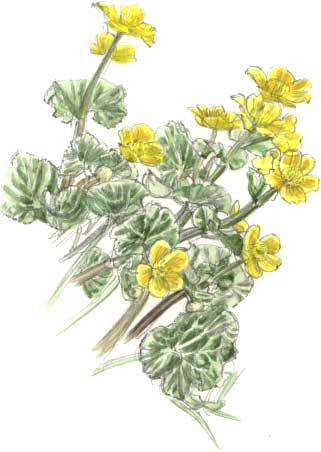
|
KingcupsWednesday, 23rd April 2003, West Yorkshire |
![]()
![]()
![]()
![]() Rocks | History |
Workshop |
Links | Home
Page
Rocks | History |
Workshop |
Links | Home
Page
![]()

In the afternoon sun small black flies rest on the blossoms of kingcups,
also known as marsh marigold Caltha palustris, a member of the
buttercup family. While I'm drawing it by the garden pond small black
beetles settle on my sketchbook. Perhaps they're pollen beetles from the
fields of oilseed rape that are now, like the kingcups, in yellow flower.
![]()
Frogs rest in the pond with their eyes just above the surface. Their activity around the frog-spawn finished about a month ago but below the surface amongst the pondweeds male smooth newts are performing their mating dances - wafting their tails at the females who trundle around moving slowly like mime artists as they investigate plants on which to lay their eggs.
![]()
Kingcups make good subjects to draw because the structure of the flowers, leaves and stems is so clear. What I hadn't reckoned on was how fidgety these plants are: in the two hours or so that I spend drawing them their stems curve and their flowers move to follow the sun. One or two flowers open up as I'm drawing.
Despite all these drawbacks I'd rather work from the living,
moving plant than from a photograph (as I was often forced to do when
I worked on botanical illustrations that had to be finished on a tight
deadline, invariably during the wrong season of the year). I want to improve
my drawing this summer so I'm hoping to have more opportunities to draw
wild flowers as they really are. I'm not aiming to create pleasing pictures
to frame up and sell, nor do I wish to produce botanical studies where
a 'perfect' specimen is portrayed in order to make identification easier;
what I'd like to do is to draw the plants just as they are.
![]()
![]() Next page | Previous
page | This day in 2000
| This month | Nature
Diary | Home
Page
Next page | Previous
page | This day in 2000
| This month | Nature
Diary | Home
Page
![]()